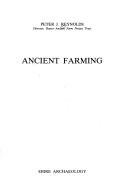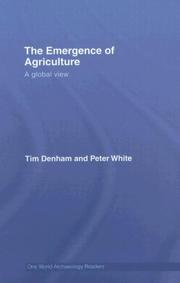| Listing 1 - 10 of 239 | << page >> |
Sort by
|
Book
ISBN: 038507185X Year: 1971 Publisher: Garden City (N.Y.) : Natural History press,
Abstract | Keywords | Export | Availability | Bookmark
 Loading...
Loading...Choose an application
- Reference Manager
- EndNote
- RefWorks (Direct export to RefWorks)
Book
ISBN: 1407311956 9781407311951 Year: 2013 Publisher: Oxford : Archaeopress,
Abstract | Keywords | Export | Availability | Bookmark
 Loading...
Loading...Choose an application
- Reference Manager
- EndNote
- RefWorks (Direct export to RefWorks)

ISBN: 0852638760 Year: 1987 Publisher: Aylesbury : Shire,
Abstract | Keywords | Export | Availability | Bookmark
 Loading...
Loading...Choose an application
- Reference Manager
- EndNote
- RefWorks (Direct export to RefWorks)
Book
Year: 2021 Publisher: London : Zed Books,
Abstract | Keywords | Export | Availability | Bookmark
 Loading...
Loading...Choose an application
- Reference Manager
- EndNote
- RefWorks (Direct export to RefWorks)
"The idea that the expression of radical beliefs is a predictor to future acts of political violence has been a central tenet of counter-extremism over the last two decades. Not only has this imposed a duty upon doctors, lecturers and teachers to inform on the radical beliefs of their patients and students but, as this book argues, it is also a fundamentally flawed concept. Informed by his own experience with the UK's Prevent programme while teaching in a Muslim community, Rob Faure Walker explores the linguistic emergence of 'extremism' in political discourse and the potentially damaging generative effect of this language. Taking a new approach which combines critical discourse analysis with critical realism, this book shows how the fear of being labelled as an 'extremist' has resulted in counter-terrorism strategies which actually undermine moderating mechanisms in a democracy. Analysing the generative mechanisms by which the language of counter-extremism might actually promote violence, Walker explains how understanding the potentially oppressive properties of language can help us transcend them. The result is an imminent critique of the most pernicious aspects of the global War on Terror, those that are embedded in our everyday language and political discourse. Drawing on the author's own successful lobbying activities against counter-extremism, this book presents a model for how discourse analysis and critical realism can and should engage with the political and how this will affect meaningful change."
Book
ISBN: 9464270179 Year: 2022 Publisher: Leiden : Sidestone Press,
Abstract | Keywords | Export | Availability | Bookmark
 Loading...
Loading...Choose an application
- Reference Manager
- EndNote
- RefWorks (Direct export to RefWorks)
Broomcorn/common/proso millet (Panicum miliaceum) is a cereal crop that originated in East Asia and was transferred westward to Europe, where it was introduced in the mid-2nd millennium BCE, at the height of the Bronze Age. Archaeobotanists from the Collaborative Research Centre 1266, supported by many colleagues, conducted a large-scale programme of radiocarbon dating of millet grains from prehistoric Europe. They discovered that the spread of this crop on the continent happened quickly, extending far and wide.What do we know about the (pre)history of this crop in Europe? The workshop organised by the CRC 1266 at Kiel University in 2019 encouraged the discussion on the circumstances and consequences of early broomcorn millet cultivation in Europe. This book brings together many of the workshop papers and reflects the diverse topics and research areas covered. The contributions inform us on the range of cultivated and collected plants from the time before and after the start of millet cultivation in Europe; present the cultural setting in which millet arrived; discuss possible reasons driving the acceptance of this innovation; and reconstruct possible uses of millet and the methods of its cultivation, processing and storage. Not just the plant economy, but also the animal economy is represented, since millet was and is grown for both humans and animals. Techniques used to trace millet archaeologically are continually being developed or improved, and this book describes the application of a few of them.This broad-based compilation of papers adds another layer to the dynamic picture of the Bronze Age and the interconnected continent. It also illustrates the complexity of the research on the diffusion of agricultural innovations.
Book
Year: 1992 Publisher: Norman University of Oklahoma Press
Abstract | Keywords | Export | Availability | Bookmark
 Loading...
Loading...Choose an application
- Reference Manager
- EndNote
- RefWorks (Direct export to RefWorks)

ISBN: 0415404444 9780415404440 0415404452 9780415404457 9781000115512 1000115518 9781000158311 1000158314 9781003060765 1003060765 9781000133462 100013346X Year: 2007 Publisher: London : Routledge,
Abstract | Keywords | Export | Availability | Bookmark
 Loading...
Loading...Choose an application
- Reference Manager
- EndNote
- RefWorks (Direct export to RefWorks)
Book
ISBN: 1789251648 9781789251647 Year: 2019 Publisher: Oxford: Oxbow books,
Abstract | Keywords | Export | Availability | Bookmark
 Loading...
Loading...Choose an application
- Reference Manager
- EndNote
- RefWorks (Direct export to RefWorks)
This study explores and demonstrates processes of cultural change in the first half of the 6th millennium cal BC, among the Koeroes and Starcevo groups of the northern marginal zones of the Balkans. Within this period and zone, which forms the southern part of the Carpathian basin, clay was the fundamental and most abundant building block of material culture, architecture, everyday life and cult practices. Clay walls, furniture, ten thousands of vessels, hundreds of clay figurines and other cult objects accumulated as huge piles of clay debris in every settlement. Traditional system of subsistence patterns ceased to fully function when these first farmers occupied cool and wet hilly forested landscapes: the environmental and cognitive challenges gradually led to the decline of this clay-centred orbit. At the same time, these changes gave birth to a no-less stunning world constructed more of timber and stones, with transformations in subsistence, material culture and rituals. This transition is inextricably bound up with the formation of the first farmers' communities of Central Europe, the Bandkeramik (LBK).
Book
Year: 2022 Publisher: Leiden : Sidestone Press,
Abstract | Keywords | Export | Availability | Bookmark
 Loading...
Loading...Choose an application
- Reference Manager
- EndNote
- RefWorks (Direct export to RefWorks)
Broomcorn/common/proso millet (Panicum miliaceum) is a cereal crop that originated in East Asia and was transferred westward to Europe, where it was introduced in the mid-2nd millennium BCE, at the height of the Bronze Age. Archaeobotanists from the Collaborative Research Center 1266, supported by many colleagues, conducted a large-scale program of radiocarbon dating of millet grains from prehistoric Europe. They discovered that the spread of this crop on the continent happened quickly, extending far and wide. What do we know about the (pre)history of this crop in Europe? The workshop organized by the CRC 1266 at Kiel University in 2019 encouraged the discussion on the circumstances and consequences of early broomcorn millet cultivation in Europe. This book brings together many of the workshop papers and reflects the diverse topics and research areas covered. The contributions inform us on the range of cultivated and collected plants from the time before and after the start of millet cultivation in Europe; present the cultural setting in which millet arrived; discuss possible reasons driving the acceptance of this innovation; and reconstruct possible uses of millet and the methods of its cultivation, processing and storage. Not just the plant economy, but also the animal economy is represented, since millet was and is grown for both humans and animals. This broad-based compilation of papers adds another layer to the dynamic picture of the Bronze Age and the interconnected continent. It also illustrates the complexity of the research on the diffusion of agricultural innovations.
Book
Year: 2022 Publisher: Leiden : Sidestone Press,
Abstract | Keywords | Export | Availability | Bookmark
 Loading...
Loading...Choose an application
- Reference Manager
- EndNote
- RefWorks (Direct export to RefWorks)
Broomcorn/common/proso millet (Panicum miliaceum) is a cereal crop that originated in East Asia and was transferred westward to Europe, where it was introduced in the mid-2nd millennium BCE, at the height of the Bronze Age. Archaeobotanists from the Collaborative Research Center 1266, supported by many colleagues, conducted a large-scale program of radiocarbon dating of millet grains from prehistoric Europe. They discovered that the spread of this crop on the continent happened quickly, extending far and wide. What do we know about the (pre)history of this crop in Europe? The workshop organized by the CRC 1266 at Kiel University in 2019 encouraged the discussion on the circumstances and consequences of early broomcorn millet cultivation in Europe. This book brings together many of the workshop papers and reflects the diverse topics and research areas covered. The contributions inform us on the range of cultivated and collected plants from the time before and after the start of millet cultivation in Europe; present the cultural setting in which millet arrived; discuss possible reasons driving the acceptance of this innovation; and reconstruct possible uses of millet and the methods of its cultivation, processing and storage. Not just the plant economy, but also the animal economy is represented, since millet was and is grown for both humans and animals. This broad-based compilation of papers adds another layer to the dynamic picture of the Bronze Age and the interconnected continent. It also illustrates the complexity of the research on the diffusion of agricultural innovations.
| Listing 1 - 10 of 239 | << page >> |
Sort by
|

 Search
Search Feedback
Feedback About UniCat
About UniCat  Help
Help News
News